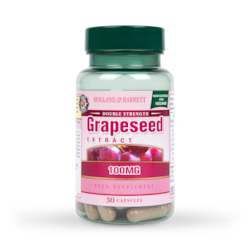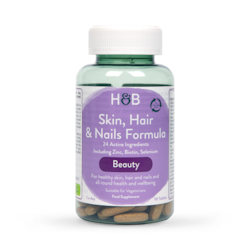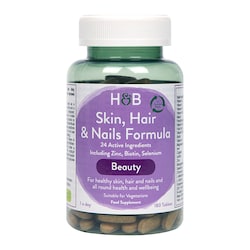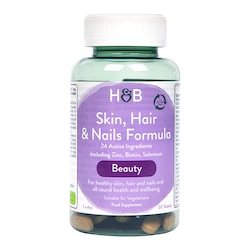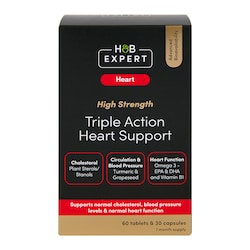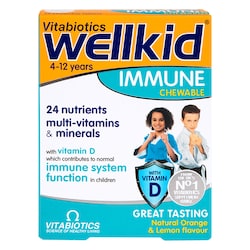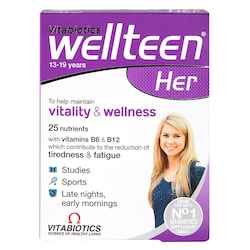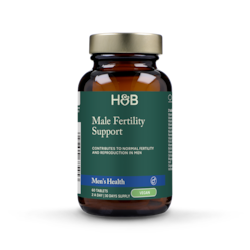15% off £30 OR 20% off £40
Code:DECIDE
5 benefits of grapeseed oil – and how to use it

We look into the benefits of grapeseed oil for skin, hair and even cooking. Find out what it is good for and how to use it here.
Summary
1What type of grapeseed oil should I buy?
Cold pressed, has been extracted just by using physical pressure. Choosing organic, the grapes were grown without pesticides, genetic modification...
2What is grapeseed oil good for?
Oil cleansing, the oil cleanse method is gaining in popularity in the skincare world. Hair treatment, you can also use grapeseed oil for hair and...
3Risks/side effects
Well tolerated by most people which is why it’s widely used as a carrier oil in many cosmetic products. If you use grapeseed oil in food, make sure...
A growing body of research points towards grapeseed oil being beneficial to many different aspects of our health.
But how can you include grapeseed oil in your life? Does it have other uses besides being a massage oil? Is grapeseed oil good for your hair? And, is it really made from grapes?
We explain what grapeseed oil is, five of its most impressive health benefits, as well as five ways you can use grapeseed oil every day.
What is grapeseed oil?
Grapeseed oil is literally that – the oil extracted from the pressed seeds of grapes.
Grapeseed oil is actually a by-product of the wine-making process. After grapes are used to make wine, the leftover seeds are then pressed and their oil is extracted.1
This oil is incredibly nutrient-dense, containing a rich array of vitamins, fatty acids and plant compounds which are known to be beneficial to our health.2
5 benefits of grapeseed oil
Grapeseed oil is full of ingredients which are good for the skin.
It contains a high amount of vitamin E – an antioxidant which can help protect from the negative effects of the sun and environmental pollution, including fumes and cigarette smoke.
Grapeseed oil also contains linoleic acid – an unsaturated fatty acid which is found naturally in the skin.
Topical use of linoleic acid is thought to help protect the skin’s structure and barrier function.3
Applied directly, grapeseed oil for skin acts as an emollient, softening and leaving the skin looking hydrated and plumped. You’ll notice the difference in your skin after just one application.
Impressively, grapeseed oil has shown in scientific studies to have significant benefits when it comes to balancing blood cholesterol levels.
In one USA study, participants took up to 45g of grapeseed oil daily which resulted in an increase of HDL-c – known as ‘good cholesterol’ by 13%. What’s more, LDL or ‘bad cholesterol’ levels dropped by 7%.4
Could grapeseed oil help mitigate some of the negative effects of a high fat diet?
It’s early days in terms of research, but grapeseed extract has shown in studies to be able to reduce fat deposition and increase the body’s metabolism of fats under some circumstances.5
One study, conducted at Yangtze University, China, concluded that grape seed oil might be helpful in the future treatment of obesity and its associated diseases.6 More research is required to determine the specific way this knowledge can be widely applied.
- Grapeseed oil is made from the pressed seeds of grapes
- It is rich in vitamins, fatty acids and phenols – beneficial plant compounds
- Grapeseed oil is wonderful for the skin and helps fight ageing
- Research has shown grapeseed oil might help lower cholesterol and manage weight
What type of grapeseed oil should I buy?
- Cold pressed
Cold pressed grapeseed oil has been extracted just by using physical pressure, and no heat or chemicals are used in the process.
Just like with olive oil, using heat or chemicals in extraction makes the process quicker, but destroys some of the beneficial components of the oil.
Cold pressed grapeseed oil may be slightly more expensive than other varieties, but to benefit from its antioxidant and fatty acids, cold pressed is best.
- Organic
Choosing organic grapeseed oil will ensure the grapes involved were grown without the use of pesticides and genetic modification.
This means that the only thing you’ll be ingesting is the pure seed oil without any traces of anything else. Therefore, organic is a good choice if you’re concerned about pesticides and other adulterations in your food and skincare.

What is grapeseed oil good for?
You can use grapeseed oil for many different things - we've gathered its 5 top u
5 uses of grapeseed oil
The oil cleanse method is gaining in popularity in the skincare world.
Cleansing your skin using an oil rich in fatty acids and vitamin E such as grapeseed oil removes excess oil, makeup and dead skin cells from the skin’s surface without stripping its natural oils.
It couldn’t be simpler – just warm a few drops of grapeseed oil between your palms before massaging into your skin for at least a minute. Then, press your face gently with a warm clean flannel to remove the oil, along with the day’s dirt.
You can also use grapeseed oil for hair and scalp health. The fatty acids in grapeseed oil help seal moisture into the hair shaft, giving strength and shine.
Further, the cleansing properties help clarify the scalp and rid it of dead skin cells and dirt, which can help promote hair health and normal growth.7
Make a simple hair mask using grapeseed oil warmed for a few seconds in the microwave. For extra scalp-clearing benefits, add a few drops of tea tree or peppermint oil.
Apply to your hair, massaging into the roots. Cover your head with a warm towel or shower cap and rinse out after 30 minutes.
Grapeseed oil for cooking is gaining attention, thanks to its impressive nutritional profile of unsaturated fatty acids, phenols and vitamin E content.8
Grapeseed oil doesn’t have a strong flavour, meaning it can fit seamlessly into a range of cuisines without overpowering the dish with its own taste.
Grapeseed oil can be drizzled onto salads, used in dips such as hummus and used to brush vegetables before roasting. Further, grapeseed oil’s high smoke point means you can also use it in shallow frying without destroying its essential fatty acids, natural antioxidants, and phytochemicals.9
Grapeseed oil for skin is a highly effective treatment which can help protect the skin from negative effects of environmental factors include sun damage.
Thanks to the linoleic acid and vitamin E it contains, grapeseed oil helps protect the skin and help to promote good skin barrier function.10
Apply grapeseed oil directly to your skin after a bath or shower and leave to absorb to improve skin look and feel.
Grapeseed oil also makes an effective overnight treatment for dry facial skin. Simply apply before bed – and wake up to soft, hydrated skin!
Grapeseed oil makes an excellent massage oil.
It’s not too greasy, it enables hands or massage tools to glide over the skin and holds some amazing skin benefits for both the giver and receiver of the massage.
For a simple grapeseed oil massage, just apply palm-warmed grapeseed oil directly to the skin and commence the massage, applying more if needed.
You can also use grapeseed oil for baby massage.
Is grapeseed oil better than olive oil?
Both grapeseed and olive oils contain lots of healthful ingredients including vitamin E, unsaturated fatty acids and antioxidants.
Grapeseed oil contains plenty of vitamin E, with up to 53 mg vitamin E per 100 g of oil – higher than that of olive oil.11
Grapeseed oil also has a higher smoke point, meaning it’s a better choice when used in cooking as the beneficial compounds won’t be destroyed by heat.
Both oils, however, are healthy and beneficial additions to both the kitchen cupboard and bathroom shelf.
Risks/side effects
Well tolerated by most people which is why it’s widely used as a carrier oil in many cosmetic products.
If you are going to use grapeseed oil in food and cooking, make sure it’s food grade. This means it has been tested to the highest standard of purity, and will ensure there have been no toxins or adulterants used in the manufacture and it is safe to ingest.12
Anyone with an allergy to grapes shouldn’t use grapeseed oil.
It’s always a good idea to perform a patch test when using any essential oil.
Using a cotton bud, dab a drop of essential oil on the inside of your elbow, cover and leave for 24 hours. If no reaction occurs, it’s most likely the oil won’t cause you any problems when used topically.
Summary
- Cold pressed, organic grapeseed oil holds the most benefits
- Grapeseed oil can be used in skincare, haircare, massage and cooking
- Grapeseed oil is fine for most people, but always do a patch test if in doubt
- https://www.researchgate.net/publication/312578959/
- https://www.ncbi.nlm.nih.gov/pmc/articles/PMC4988453/
- https://lpi.oregonstate.edu/mic/health-disease/skin-health/essential-fatty-acids
- https://www.ncbi.nlm.nih.gov/pmc/articles/PMC4988453/#b60-nmi-9-2016-059
- https://www.karger.com/Article/FullText/502235
- https://www.karger.com/Article/FullText/502235
- https://draxe.com/nutrition/grapeseed-oil-for-hair/
- https://www.ncbi.nlm.nih.gov/pmc/articles/PMC4988453/
- https://www.sciencedirect.com/topics/agricultural-and-biological-sciences/grapeseed-oil
- www.ncbi.nlm.nih.gov/pmc/articles/PMC4988453/
- www.ncbi.nlm.nih.gov/pmc/articles/PMC4988453/
- https://www.food.gov.uk/business-guidance/food-contact-materials-regulations


